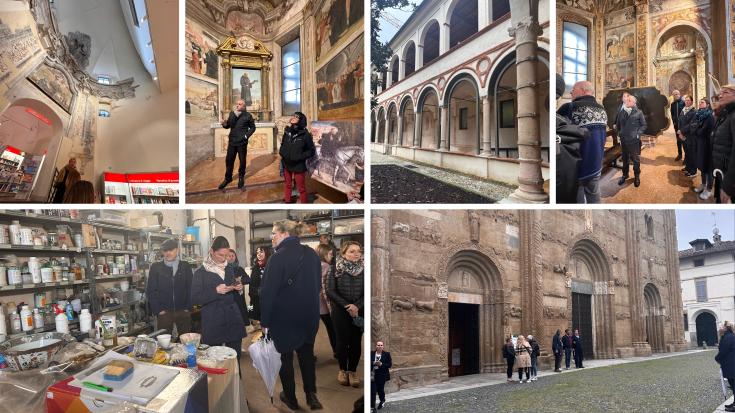Study Visit showcases innovative reuse of Religious Heritage
During the kick off meeting it was organized a study visit to Pavia (Italy), showcasing exemplary cases of repurposing religious heritage sites for modern use. This initiative highlights the intersection of heritage preservation, community engagement, and educational innovation.
Visit to the Piccolo Chiostro San Mauro
The tour began with a visit to the Piccolo Chiostro San Mauro, an outstanding example of cofunctionalization of religious heritage. This site now houses a startup specializing in cultural heritage study and preservation. For more information on the Piccolo Chiostro San Mauro, visit restauropiccolochiostro.com and piccolochiostro.it.
The presence of a startup within a religious heritage building holds significance for several reasons:
- Preservation of Heritage: It underscores the reuse of historical spaces, ensuring their continued relevance and preservation while supporting innovative endeavors.
- Community Engagement: By occupying a familiar and culturally significant site, the startup fosters community engagement and awareness about the importance of heritage preservation. Plus, it creates job opportunities in the area.
- Educational Opportunities: Through activities such as training programs and public outreach, the startup contributes to knowledge dissemination and skill development in heritage preservation, enriching the local community and beyond.
The visit was led by Mario Colella, Professor and Restorer responsible for the startup, and Don Franco Tassone, Parish Priest of San Mauro Parish (Pavia), overseeing Social and Work Pastoral for Pavia’s Diocese. They explained the key aspects of the building's restoration for its social purposes and the various agreements and legal processes that enable these activities, all while respecting the religious character of the building.
Visit to the Feltrinelli Bookshop
Participants also visited the Feltrinelli Bookshop on Via XX Settembre, housed in the ancient San Rocco Church. This site, rich with history, features beautiful frescoes above the stairs leading to the second room, remnants of its past as a place of worship. Originally home to the 'Confraternità della Pietà', the church served a unique role in assisting those condemned to death, with practices continuing until 1808. Before becoming a bookshop, the location was the Roma Cinema until the late 1990s.
Visit to the San Felice Complex
The visit continued to the San Felice complex at the University of Pavia, an example of the reuse of religious heritage for educational purposes as the headquarters of the Faculty of Economy. Explained by engineers and architects from the studio that carried out the work, participants had the opportunity to explore the entire complex while receiving detailed explanations about its restoration and transformation.
Walking Tour of Religious Buildings
The study visit concluded with a walking tour of the main religious buildings in the city. During this tour, participants learned about the various transformations of these buildings, gaining insights into their historical significance and modern adaptations
